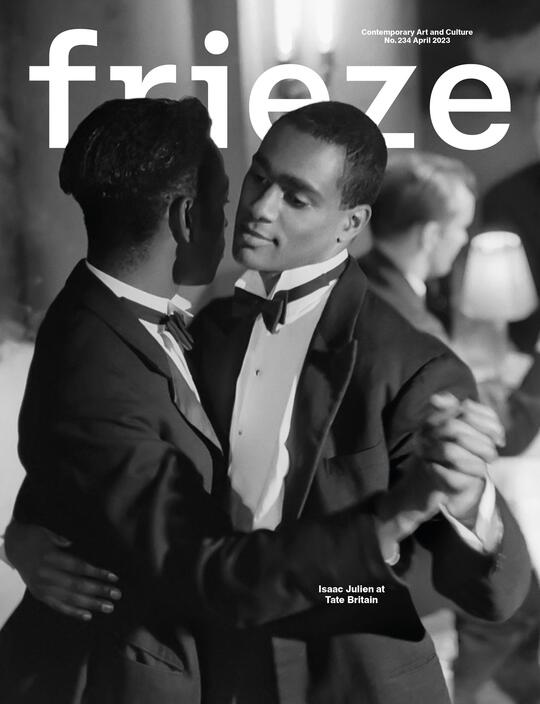Rob Kulisek Dissolves the Distinctions Between Rehab Patients and Staff
At VI, VII, Oslo, the artist merges a young influencer with the clinicians of a luxury Swiss treatment facility
At VI, VII, Oslo, the artist merges a young influencer with the clinicians of a luxury Swiss treatment facility

‘Meg at Paracelsus’, Rob Kulisek’s solo exhibition at VI, VII, presents 13 composite photographs of Meg Yates – a 20-something New York Instagram model with raccoon eyes and the wardrobe of a young Courtney Love – superimposed onto monochrome headshots of personnel at Paracelsus, a luxury private rehab facility in Zurich. Alongside these works, which were first published in the Opioid Crisis Lookbook (2020), are around two dozen printouts that show Yates photoshopped into the clinic and its picturesque surroundings (Big Book, all works 2023). Taped and tacked onto a single wall, these black and white images, which look as if they have been ripped straight out of a 1990s grunge fanzine, stand in stark contrast to the neatly hung headshots.

The exhibition’s appeal is rooted in the contradictions it sets up: fiction/reality (Yates never went to the clinic but, according to the press release, has struggled with addiction); private/public (Yates is a private person with a publicized life; the clinicians are the public faces of a closeted world); and vulnerability/the financialization of care (the clinic costs upwards of US$100,000 per week). The most gripping of these tensions is between Yates’s grimy but vibrant aesthetic and the sterile, softly lit portraits of the clinicians, which were taken from Paracelsus’s website. Due to COVID-19 restrictions, Yates shot the images of herself alone in her New York apartment according to instructions from the artist. As a result, her body is shown at odd angles that transgress the photographs’ narrow vertical frames and her pale face is often obscured. In contrast, the clinic’s doctors, therapists, nurses, yoga instructor and, surprisingly – although perhaps not that surprisingly – tennis coach, look directly into the camera, smiling.

In their duplication and deformation, the images are reminiscent of Francis Bacon’s grotesque figures. In Meg at Paracelsus I (CEO), the eyes of the facility’s CEO stare out at us from Yates’s breasts; in Meg at Paracelsus VII (Psychologist), her mouth eats away at the nose of a psychologist; whilst in Meg at Paracelsus IV (Addictions Counsellor), an eye is poked out with a cigarette. Elsewhere, jawlines are dislocated, limbs cut off, flesh burned away and, in Meg at Paracelsus III (Medical Director), the rippling fabric of Yates’s black dress recalls exposed tendons and bones. Somewhere between the culture of fashion, the lonesomeness unique to social media and the cost of care, it becomes unclear where a human being ends and the gross commodification of their lives begins.

Kulisek’s superimpositions render the juxtaposed people’s physical qualities at once more pronounced and uncertain. This is especially poignant in the photos where the effect isn’t one of deformation of outline but symbiosis of features. Here, the characters – all women – haunt each other. The CEO, whose outline is entirely filled by an image of Yates making a horn sign behind her head, carries a devil within her. The nurse, who bears a startling resemblance to the mysterious and angelic Laura Palmer (Sheryl Lee) from Twin Peaks (1990–91), harbours an evil, grinning faun not unlike a young Patty Hearst, who was kidnapped by the Symbionese Liberation Army in 1974 and then famously switched sides.

Meg at Paracelsus IX (Acupuncturist) is arguably the most complex – and gut-wrenching – work in the series. Superimposed on the unsmiling employee, Yates looks vulnerable rather than assertive. She is smaller here than in any of the other images: her posture passive, her expression withdrawn. But what is perhaps most striking is how alike they are: one could be the older version of the other. And maybe that’s the point. Ultimately, the patient and the clinicians aren’t opposites at all, but interchangeable subjects of the very same affective economy, where intimacy is impersonal and the impersonal intimate.
Rob Kulisek’s ‘Meg at Paracelsus’ is on view at VI, VII, Oslo, until 5 March.
Main image: Meg at Paracelsus VI (Clinical Coordinator), 2023, digital C-type print. Courtesy: the artist and VI, VII, Oslo






















